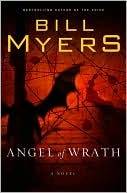
Unfortunately, the problems in Bill Myers' Angel of Wrath are legion.
Wallowing. I've found that there is a feel to most thrillers that's troubling, and this story follows that trend. It's as though the writer revels in the violence, fear, and death, and that's just wrong. The focus here seemed thoroughly negative. No doubt there's some kind of amazing epiphany later, but I don't think it's possible to go negative for two-thirds of the story and suddenly reverse the effect on the reader in probably well under one-third.
Holier Than They. Also, there's a kind of sanctimony involved here, and it's a bit misplaced at times. For example, there's an undercurrent of glee in the sinful churchgoers getting theirs. Now, most of the victims have some kind of moral or ethical problem--put more bluntly, they are sinning in some fashion explicitly condemned in Scripture. (Some might argue about the abortionist, but I think even many "pro-choice" people will admit that there's an understandable problem.) But there is an odd man out--supposedly a false teacher. While I am not an evolutionist, I don't see that an evolutionist would necessarily be a false teacher from a Biblical standpoint. His teaching is in a secular context (as a high-school teacher), not in the context of teaching Scripture or doctrine. The remarks about evolutionary racism are also ill-considered. While some racists have justified their views through evolution, some have used the Bible for the same purpose. Christians shouldn't engage in strawman tactics.
Evil Christians! I can understand wanting to avoid an unnecessarily rosy portrayal of Christians, but here Christians actually seem more evil than others. The pastor is more concerned with image than with God. His father (also a pastor once) sexually abused his own daughter. Then there are the aforementioned Sinners In The Hands Of An Angry Psycho. I guess it wouldn't bother me so much if there were a counter-balance--an opposing view that would relieve the bleakness. The closest thing is the Praise-and-Worship geek, and since she's an unbiblical pop-theology construct, that's no great comfort.
Fairness Doctrine. The author gives more time to some bad theology than I'm comfortable with. There's a bit more detail on Black Mass than is necessary--I know kids can find out that sort of thing on Wikipedia, but we shouldn't do the lookups for them. A fair amount of the bad stuff is imitable, and the Coolness Factor of reproducing some of it will far outweigh the clearly fictional consequences.
We Don't Need God; We Have Physics! There's a strong tendency these days to rationalize God into some really quirky quantum phenomenon--another troubling trend this story follows. Apparently in the previous episode, a machine--a non-spiritual object--enabled people to access the Voice of God. Jazmin, a quasi-prodigy, becomes God-conscious as a result, and that enables her to pick out the Praise Geek as the Only One Who Gets What's Happening.
One of the things that bothered me was the whole business of bringing in string theory and vibrations, as though string theory is going to reduce God to a formula or phenomenon. Also, the use of the Fall of Jericho and Jehoshaphat's victory over the invading armies is inaccurate. What brought the walls down in the first case was obedience to God's command, and the fighting that followed was apparently normal. The idea that sound was involved is a back-reading of modern faith in physics. That leaves us with Jehoshaphat, where again obedience was probably the key, yet even so it's anomalous: the exception, not the rule. Normally, God expected the warriors to do their job, not stand around while the praise band did its thing.
We Don't Need No Steenkin' Prayer! While I haven't finished the story, I strongly suspect that the demon is routed by by an Amazing Praise and Worship Extravaganza. This is nonsense. Contrary to what many believe, such things don't really bother Satan. Think about it: presumably the continuous chorus of praise in Revelation has been there for some time, yet Satan still came before God in Job without apparent trouble. On a personal level, some of the worst Satanic activity I've encountered occurred in a worship setting.
This calls for a quote or two:
Cindy the Praise Geek: "What would you think if I contacted a few of the choir members and we got together?"
"For prayer?" [the pastor] asked.
"No, uh--"
"For singing," Jaz interrupted.
[small cut]
"I could call them up," [Cindy] said. "The ones who wanted could meet us over at the church."
"To sing," [the pastor] repeated.
"To...worship, yes. And we could pray, too." (pp. 198-199, ellipses in original)
Prayer is apparently an afterthought here.
The Envelope, Please. Okay, I just checked the ending. Singing, not prayer, is the big deal. Maybe Jesus should've said, "This kind doesn't go out except by Praise and Worship." Reality check: the song in question is used by various non-Christian groups. It has no inherent power to drive out demons, and as mentioned above, praise and worship have no noticeable effect on Satan. Oh, and familial love (with repentance, yes) turns out to be strong enough to clock a demon. (And it is familial love: it is stated in precisely those terms on p. 288.) But only God's love could succeed there; human love of any kind is too weak.
Conclusion. So this winds up being a pop-theology fantasy of a dangerous kind: it encourages false views that could harm those who believe them. And the attitude issues don't help. If you don't like thinking through implications and don't care about theology, you'll probably like the book. Otherwise, skip it.








